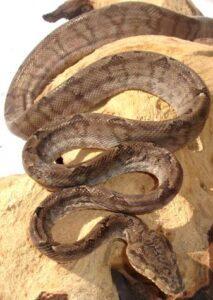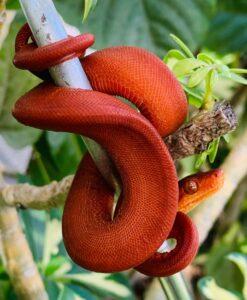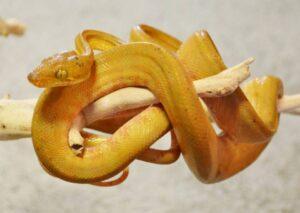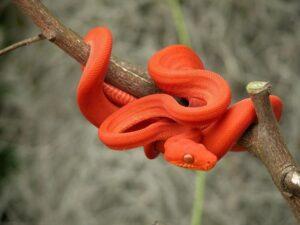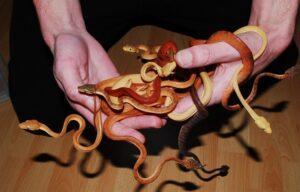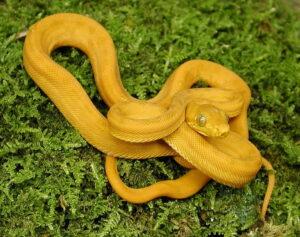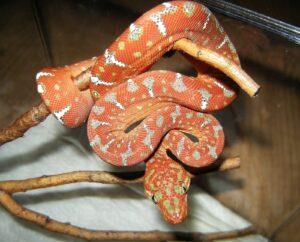
Amazon tree boas are best known for their striking colors and patterns. However, it is aggressive and doesn’t hesitate to bite at the slightest or even no provocation. It is also known by the names garden tree boa, Cook’s tree boa, common tree boa, and macabrel. Their care and handling needs are very specific.
Scientific Classifications
- Suborder:Serpentes
- Family:Boidae
- Genus:Corallus
- Species:C. hortulana
Conservation Status
Subspecies and Morphs
There are no recognized subspecies of this snake. The potential of garden tree boas to produce unconventional colors of offspring has led breeders to develop many morphs. The most common ones are,
- Paradox
- Tiger
- Leopard
- Calico or candy cane
Description
Size
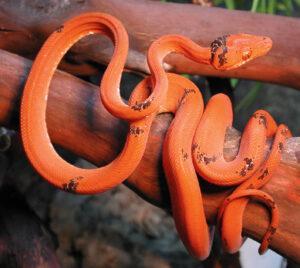
The full-grown adults of this species reach a length of 5-6.5 ft (1.5-2 m).
Color and Appearance
This species comes in a wide range of colors and patterns. You can group them into two distinct color phases, colored and garden. Snakes of the colored phase are an attractive combination of yellow, orange, and red, while the garden phase snakes are usually dull brown, gray, and black. However, the latter display an amazing range of patterns that make up for their dull hues.
They could be speckled, banded, saddled, or plain. Some of the colored snakes can have their red bodies decorated with yellow patterns, or yellow bodies can have red or orange patterns on them.
They have black tongues and long, needle-like sharp teeth for gripping their prey.
Are They Dangerous to Humans
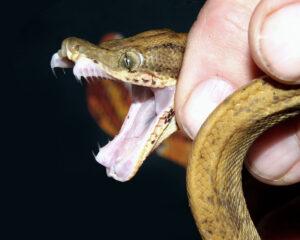
The Amazon tree boa is not venomous, so it can’t kill you. But it is very aggressive and can inflict a painful bite without warning. You can get an infection from its bite, just like any other animal bites. You can get the worst injury when you pull back when it is latched onto you. It could cause tearing of your skin. Being relatively small, even as an adult, this is as much it can do to hurt you.
If you approach a captive snake at night, it will consider your hand as potential prey and inevitably bite. It might break your skin as it draws in blood. Once bitten, you need to clean and disinfect the wound. Most cases don’t need any medical attention.
Amazon Tree Boas at a Glance
Distribution
You will find them in southern Columbia east of the Andes, Guyana, French Guiana, Costa Rica, Peru, Ecuador, Bolivia, Amazonian Brazil, southern Venezuela, and Suriname in South America.
Habitat
They live in trees and prefer humid climates like rainforests but can also be found in dry biomes and savannahs.
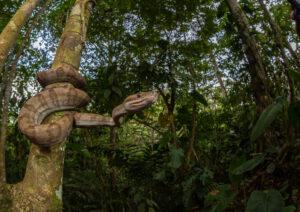
It spends its time basking, climbing, and coiling on branches.
Lifespan
In the wild, the average lifespan of the garden tree boa is 15 years. In human care, it is 20 year
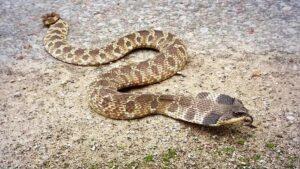
Predators
Birds of prey are the natural predators of the boa. Its color helps it to camouflage to avoid detection by its enemies effectively.
Diet
The nocturnal hunters feed on rodents, bats, lizards, frogs, insects, and birds.
Reproduction
Viviparous (females give birth to live young)
Usually, babies are born towards the end of the rainy season, with the litter size ranging from 5-20. The neonates are slim, independent, and around 30 cm in length. Their colors could be entirely different from that of their parents. You could have two dull garden phase boas giving birth to beautiful colored babies.
Care Sheet
Temperament: Though the snakes find favor with the pet industry for their looks, they are infamous for their irritable temperament and tendency to bite. They need to be handled with great care, but many fail to tolerate it due to their overly defensive nature.
Temperature: The basking area should be between 88°F and 93°F, while the remaining part of the tank should have cooler ambient temperatures of 82°F-85°F. Temperature drops of 10-15 degrees are acceptable at night. If it falls below that, you need to use a heating system.
Humidity: A 40% – 70% humidity level is ideal for this snake. A medium-sized water dish should be placed at the bottom of the vivarium.
Substrate: A porous substrate that absorbs moisture helps maintain the required humidity. Coconut husk, cypress mulch, and orchid bark are good options.
Source
2.bp.blogspot.com, live.staticflickr.com, reptilesmagazine.com, scontent.fccu4-2.fna.fbcdn.net, static.inaturalist.org, i.pinimg.com, lllreptile.com, i.pinimg.com, reptilehow.com, mysnakepet.com, static.inaturalist.org, w0.peakpx.com

